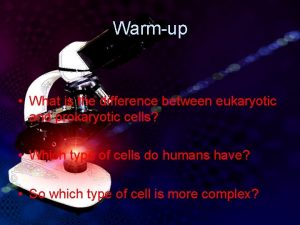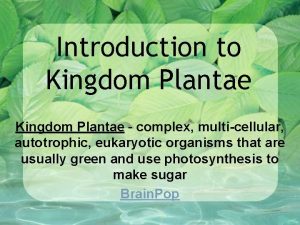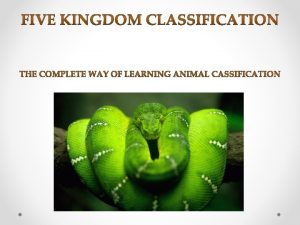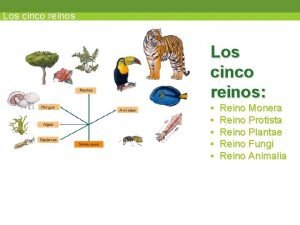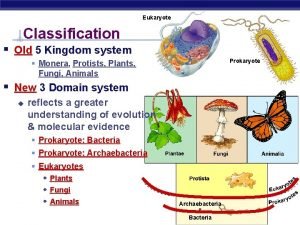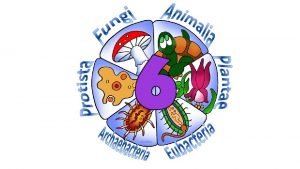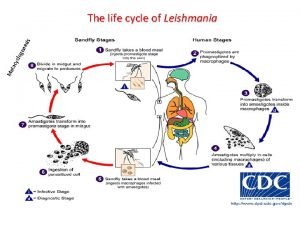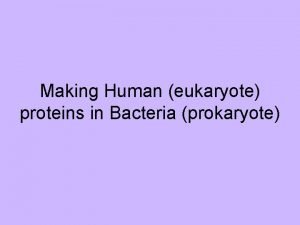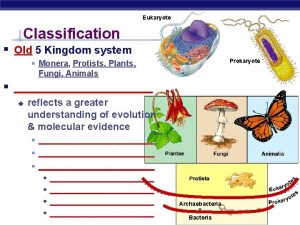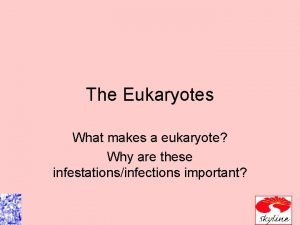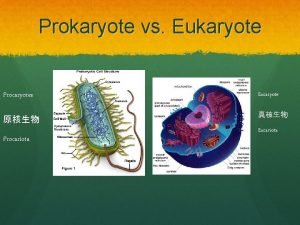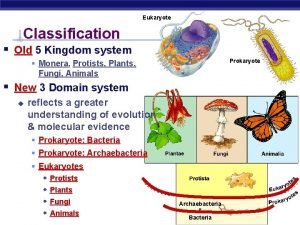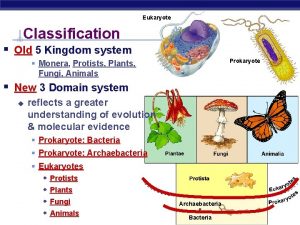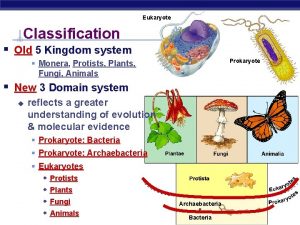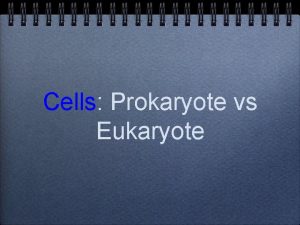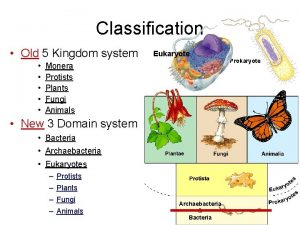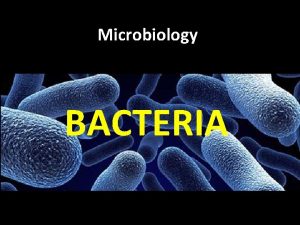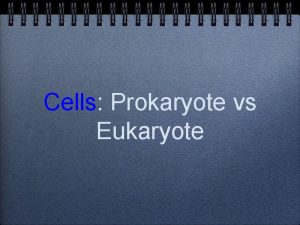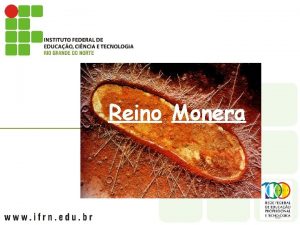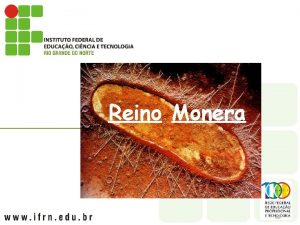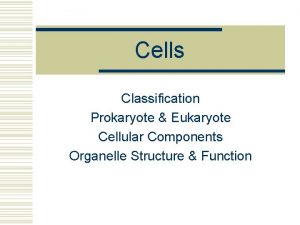Eukaryote Classification Old 5 Kingdom system Prokaryote Monera



















- Slides: 19


Eukaryote Classification § Old 5 Kingdom system Prokaryote § Monera, Protists, Plants, Fungi, Animals § New 3 Domain system u reflects a greater understanding of evolution & molecular evidence § Prokaryote: Bacteria § Prokaryote: Archaebacteria AP Biology § Eukaryotes w Protists w Plants w Fungi w Animals 2 Archaebacteria & Bacteria

AP Biology Kingdom Bacteria Kingdom Archaebacteria Kingdom Protist Kingdom Fungi Kingdom Plant 3 Kingdom Animal

Prokaryotes Domain Bacteria Domain Archaebacteria Domain Bacteria AP Biology Domain Archaea Common ancestor Domain Eukarya

Bacteria live EVERYWHERE! § Bacteria live in all ecosystems on plants & animals u in the soil u in depths of the oceans Microbes always u in extreme cold find a way to make a living! u in extreme hot u in extreme salt u on the living u on the dead u AP Biology 5

Bacterial diversity Bonnie Bassler How Bacteria Talk to Each Other rods and spheres and spirals… Oh My! Basic shapes Coccus Spirilla bacillus Fancier shapes staph- a cluster strep- a linear chain AP Biology 6

eukaryote cell Prokaryote Structure § Unicellular u prokaryote cell bacilli, cocci, spirilli § Size u 1/10 size of eukaryote cell § 1 micron (1 um) § Internal structure u u AP Biology no internal compartments § no membrane-bound organelles § only ribosomes circular chromosome, naked DNA § not wrapped around proteins (histones) § Some have plasmids 7

Prokaryote vs. Eukaryote Chromosome Prokaryote Eukaryote double helix AP Biology 8

mitochondria Variations in Cell Interior cyanobacterium (photosythetic) bacterium aerobic bacterium chloroplast AP Biology inter na for p l memb rane hoto s s like a ch ynthesis (thyl loroplas t akoi ds) 9 nes a r b em m l a on n i t r a e t r i in sp ion e r r d r n fo cho o t i m a e) e a t k s li i (cr

Prokaryote Cell Wall Structure How to Gram Stain bacteria Gram-positive bacteria peptide side chains cell wall peptidoglycan plasma membrane That’s important for your doctor to know! protein peptidoglycan = polysaccharides + amino acid chains lipopolysaccharides = lipids + polysaccharides Gram-negative bacteria cell wall outer membrane of lipopolysaccharides outer membrane peptidoglycan AP Biology 10 plasma membrane

Prokaryotic metabolism § How do bacteria acquire their energy & nutrients? u photoautotrophs § photosynthetic bacteria u chemoautotrophs § oxidize inorganic compounds w nitrogen, sulfur, hydrogen… u heterotrophs § live on plant & animal matter § decomposers & pathogens AP Biology 11

Genetic variation in bacteria § Mutations u bacteria can reproduce every 20 minutes § binary fission u error rate in copying DNA § 1 in every 200 bacteria has a mutation § you have billions of E. coli in your gut! w lots of mutation potential! § Genetic recombination u bacteria swap genes § plasmids w small supplemental circles of DNA § conjugation AP Biology conjugation w direct transfer of DNA 12

Horizontal Gene Transfer § As opposed to “parent” to “offspring” § Can be done 3 ways Conjugation= bacteria to bacteria u Transduction=virus to bacteria u Transformation= from exogenous material to bacteria (or eukaryotic cells) u AP Biology 13

§ One bacterium conjugation serves as the donor of genetic information while the other is the recipient u u AP Biology 14 Could be a fertility factor or resistance factor that is given Passed in the form of a plasmid (small circular piece of DNA) through a pilus (conjugation tube)

Transduction -a virus can introduce DNA from one host into another host -the new host incorporates the new DNA and starts to make copies of it AP Biology 15

Transformation vs. transfection § Exogenous DNA is taken up by a bacterium and incorporated Bacteria can do u Eukaryotes can do u AP Biology 16

Bozeman on Bacteria AP Biology 17

Bacteria as pathogens § Disease-causing microbes u plant diseases § wilts, fruit rot, blights u animal diseases § § § § AP Biology tooth decay, ulcers anthrax, botulism plague, leprosy, “flesh-eating” disease STDs: gonorrhea, chlamydia typhoid, cholera TB, pneumonia lyme disease 18

Bacteria as beneficial (& necessary) § Life on Earth is dependent on bacteria u decomposers § recycling of nutrients from dead to living u nitrogen fixation § only organisms that can fix N from atmosphere w needed for synthesis of proteins & nucleic acids w plant root nodules u help in digestion (E. coli) § digest cellulose for herbivores w cellulase enzyme § produce vitamins K & B 12 for humans u produce foods & medicines § from yogurt to insulin AP Biology 19
 Eukaryote prokaryote difference
Eukaryote prokaryote difference Prokaryotes and eukaryotes
Prokaryotes and eukaryotes Prokaryotic v. eukaryotic cells
Prokaryotic v. eukaryotic cells Prokaryotic cells do not have
Prokaryotic cells do not have Old kingdom middle kingdom new kingdom
Old kingdom middle kingdom new kingdom Nnn ruled
Nnn ruled Youtube
Youtube Old kingdom middle kingdom new kingdom
Old kingdom middle kingdom new kingdom A multicellular autotrophic organism with vascular tissue
A multicellular autotrophic organism with vascular tissue Kingdom monera classification chart
Kingdom monera classification chart Reino animal vegetal fungi monera y protista
Reino animal vegetal fungi monera y protista Prokaryote
Prokaryote Are amoeba prokaryotic or eukaryotic
Are amoeba prokaryotic or eukaryotic Coding.oge
Coding.oge Eukaryote
Eukaryote Eukaryote
Eukaryote What makes something a eukaryote
What makes something a eukaryote Brain warmer
Brain warmer Procariota organelas
Procariota organelas Monera
Monera
